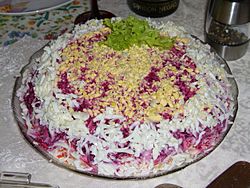Dressed herring facts for kids
 |
|
| Alternative names | Herring under a fur coat |
|---|---|
| Type | Salad |
| Place of origin | Russia |
| Associated national cuisine | Belarusian, Latvian, Lithuanian, Russian, Ukrainian, Moldovan |
| Main ingredients | Herring, vegetables (potatoes, carrots, beetroots), onions, mayonnaise |
Dressed herring, often called herring under a fur coat, is a famous layered salad. It's made with diced pickled herring at the bottom. On top of the herring, there are layers of grated boiled eggs and different vegetables. These include potatoes, carrots, and beetroots. Chopped onions and creamy mayonnaise complete the dish. Some versions might even include a layer of fresh grated apple.
Contents
What is Dressed Herring?
Dressed herring is a special kind of layered salad. People often call it "herring under a fur coat" (which in Russian is "sel'd pod shuboy"). This is because of how the different layers look, like a warm coat covering the fish. The main ingredient is pickled herring, which is a type of fish preserved in a tangy liquid.
The Colorful Layers
This salad is built with several delicious layers. First, you have the diced (small cut) pickled herring. On top of that, there are layers of grated boiled eggs, mashed potatoes, and shredded carrots. You'll also find chopped onions mixed in.
The Purple "Fur Coat"
The most striking part of dressed herring is its vibrant purple color. This comes from the top layer, which is made of grated boiled beetroot. Beetroot is a root vegetable that stains everything a deep red or purple. This layer, covered with creamy mayonnaise, gives the salad its famous "fur coat" look. Sometimes, people add a layer of fresh grated apple for a slightly sweet and tart taste. The salad is often decorated with grated boiled eggs, using either the whites, yolks, or both.
Where is Dressed Herring Popular?
Dressed herring is very popular in countries that were once part of the Soviet Union. This includes Russia, Ukraine, Belarus, Lithuania, and Latvia. It's a common dish for holidays, especially for New Year (Novy God) and Christmas celebrations. It's often served as a "zakuska," which is a type of appetizer or snack, in places like Belarus, Russia, and Kazakhstan.
See also
 In Spanish: Sel'd' pod shuboi para niños
In Spanish: Sel'd' pod shuboi para niños

